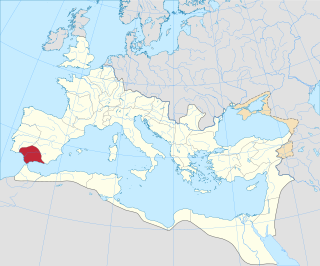Related Research Articles

Lusitania or Hispania Lusitana was an ancient Iberian Roman province located where modern Portugal and part of western Spain lie. It was named after the Lusitani or Lusitanian people.

Hispania Baetica, often abbreviated Baetica, was one of three Roman provinces in Hispania. Baetica was bordered to the west by Lusitania, and to the northeast by Hispania Tarraconensis. Baetica remained one of the basic divisions of Hispania under the Visigoths down to 711. Baetica was part of Al-Andalus under the Moors in the 8th century and approximately corresponds to modern Andalusia.
Gaius Julius Severus was a Roman senator and aristocrat of the second century. He was suffect consul around the year 138.
Gaius Caesonius Macer Rufinianus was a Roman military officer and senator who was appointed suffect consul in around AD 197 or 198. He was the first member of gens Caesonia to hold a consulship.
Lucius Catilius Severus Julianus Claudius Reginus was a Roman senator and general active during the reigns of Trajan and Hadrian. He was appointed consul twice: the first time in 110 CE with Gaius Erucianus Silo as his colleague; the second in the year 120 with the future emperor Antoninus Pius as his colleague. Catilius was also the step-great-grandfather of the emperor Marcus Aurelius.
The gens Oppia was an ancient Roman family, known from the first century of the Republic down to imperial times. The gens may originally have been patrician, as they supplied priestesses to the College of Vestals at a very early date, but all of the Oppii known to history were plebeians. None of them obtained the consulship until imperial times.
Gaius Curtius Justus was a Roman senator who held several posts in the emperor's service during the Antonine dynasty. He was suffect consul in 151 with Publius Julius Nauto as his colleague. Justus is known primarily through surviving inscriptions, although he could be identical with the Curtius Justus mentioned as a scriptor rei rusticae by Gargilius Martialis (2.1.4,7).
Quintus Pomponius Rufus was a Roman senator active in the imperial service; he was governor during the reigns of the emperors Domitian and Trajan. Rufus was also suffect consul for the nundinium September-December AD 95 as the colleague of Lucius Baebius Tullus. Pomponius Rufus is known primarily from inscriptions.
Gaius Calpurnius Flaccus was a Roman senator of the second century. He was attested suffect consul with Lucius Trebius Germanus as his colleague on 15 December of an undetermined year between 122 and 127. Both Flaccus and Germanus are primarily known from inscriptions.
Marcus Cutius Priscus Messius Rusticus Aemilius Papus Arrius Proculus Julius Celsus was a Roman senator who held a series of offices in the emperor's service. He was suffect consul for the nundinium of May to August 135 as the colleague of Lucius Burbuleius Optatus Ligarianus. Papus is known solely through inscriptions.
Titus Calestrius Tiro Orbius Speratus was a Roman senator who held a series of offices in the emperor's service. He was suffect consul late in the year 122 as the colleague of Gaius Trebius Maximus.
Quintus Fuficius Cornutus was a Roman senator active in the first half of the second century AD, who held a number of offices in the emperor's service. He was suffect consul for the nundinium April-June AD 147 with Aulus Claudius Charax as his colleague. Cornutus is known only from inscriptions.
Gaius Javolenus Calvinus was a Roman senator of the 2nd century AD who occupied a number of offices in the imperial service, as well as serving as suffect consul between 140 and 143.
Quintus Voconius Saxa Fidus was a Roman senator, who was active during middle of the second century. He was suffect consul in the nundinium September-October 146 with Gaius Annianus Verus as his colleague. He is known almost entirely from inscriptions; Voconius is mentioned once in Ulpian's Libro octavo de officio proconsulis.
Gaius Julius Proculus was a Roman senator, who held a number of imperial appointments during the reign of Trajan. He was suffect consul in the nundinium of May to August 109 as the colleague of Gaius Aburnius Valens. He is known entirely from inscriptions. Anthony Birley notes there is a plausible possibility that Proculus also held a second suffect consulate; any man recorded as holding a second consulate after AD 103, held it as an ordinary consul, not as a suffect consul.

Titus Caesernius Statianus was a Roman senator who held a number of appointments in the Imperial service during the reigns of Hadrian and Antoninus Pius. He was suffect consul in the nundinium of September-October 141; his colleague's name is not known. His full name is Titus Caesernius Statius Quinctius Statianus Memmius Macrinus.
Titus Caesernius Quinctianus was a Roman senator who held a number of appointments in the Imperial service during the reigns of Hadrian and Antoninus Pius. He was suffect consul in an undetermined nundinium around the year 138. His full name was Titus Caesernius Statius Quinctius Macedo Quinctianus.
Quintus Caecilius Marcellus Dentilianus was a Roman senator, who held several imperial appointments during the reign of Antoninus Pius. He was suffect consul in an undetermined nundinium around AD 150. He is known entirely from inscriptions.
Publius Cluvius Maximus Paullinus was a Roman senator, who held a number of imperial appointments during the reigns of Hadrian and Antoninus Pius. He was suffect consul during an undetermined nundinium between 139 and 143. He is known entirely from inscriptions.